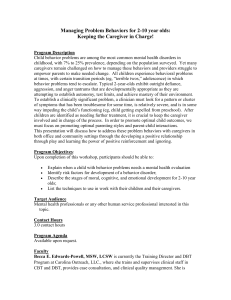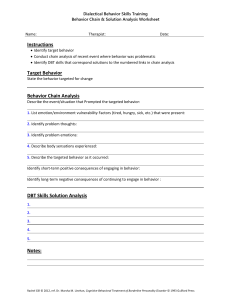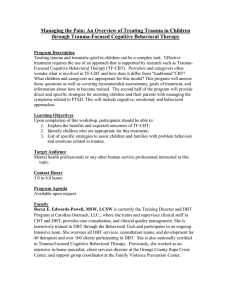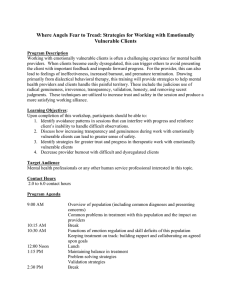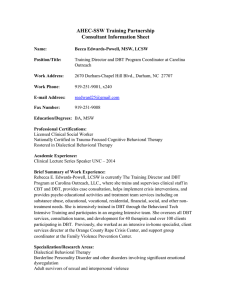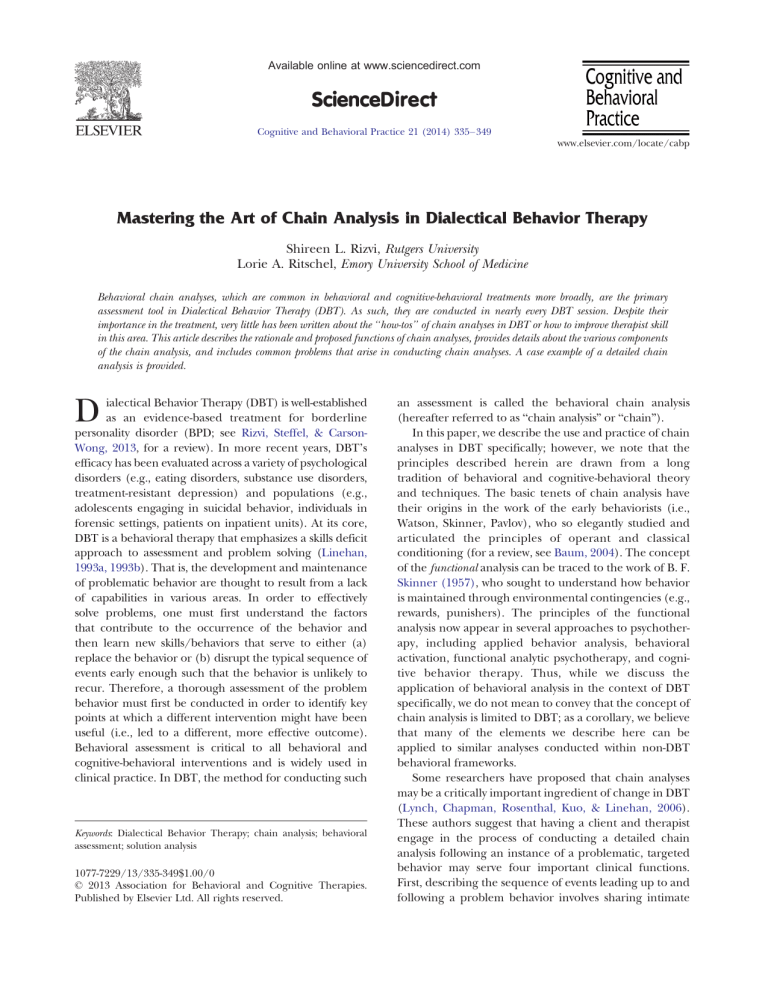
Available online at www.sciencedirect.com ScienceDirect Cognitive and Behavioral Practice 21 (2014) 335–349 www.elsevier.com/locate/cabp Mastering the Art of Chain Analysis in Dialectical Behavior Therapy Shireen L. Rizvi, Rutgers University Lorie A. Ritschel, Emory University School of Medicine Behavioral chain analyses, which are common in behavioral and cognitive-behavioral treatments more broadly, are the primary assessment tool in Dialectical Behavior Therapy (DBT). As such, they are conducted in nearly every DBT session. Despite their importance in the treatment, very little has been written about the “how-tos” of chain analyses in DBT or how to improve therapist skill in this area. This article describes the rationale and proposed functions of chain analyses, provides details about the various components of the chain analysis, and includes common problems that arise in conducting chain analyses. A case example of a detailed chain analysis is provided. D ialectical Behavior Therapy (DBT) is well-established as an evidence-based treatment for borderline personality disorder (BPD; see Rizvi, Steffel, & CarsonWong, 2013, for a review). In more recent years, DBT’s efficacy has been evaluated across a variety of psychological disorders (e.g., eating disorders, substance use disorders, treatment-resistant depression) and populations (e.g., adolescents engaging in suicidal behavior, individuals in forensic settings, patients on inpatient units). At its core, DBT is a behavioral therapy that emphasizes a skills deficit approach to assessment and problem solving (Linehan, 1993a, 1993b). That is, the development and maintenance of problematic behavior are thought to result from a lack of capabilities in various areas. In order to effectively solve problems, one must first understand the factors that contribute to the occurrence of the behavior and then learn new skills/behaviors that serve to either (a) replace the behavior or (b) disrupt the typical sequence of events early enough such that the behavior is unlikely to recur. Therefore, a thorough assessment of the problem behavior must first be conducted in order to identify key points at which a different intervention might have been useful (i.e., led to a different, more effective outcome). Behavioral assessment is critical to all behavioral and cognitive-behavioral interventions and is widely used in clinical practice. In DBT, the method for conducting such Keywords: Dialectical Behavior Therapy; chain analysis; behavioral assessment; solution analysis 1077-7229/13/335-349$1.00/0 © 2013 Association for Behavioral and Cognitive Therapies. Published by Elsevier Ltd. All rights reserved. an assessment is called the behavioral chain analysis (hereafter referred to as “chain analysis” or “chain”). In this paper, we describe the use and practice of chain analyses in DBT specifically; however, we note that the principles described herein are drawn from a long tradition of behavioral and cognitive-behavioral theory and techniques. The basic tenets of chain analysis have their origins in the work of the early behaviorists (i.e., Watson, Skinner, Pavlov), who so elegantly studied and articulated the principles of operant and classical conditioning (for a review, see Baum, 2004). The concept of the functional analysis can be traced to the work of B. F. Skinner (1957), who sought to understand how behavior is maintained through environmental contingencies (e.g., rewards, punishers). The principles of the functional analysis now appear in several approaches to psychotherapy, including applied behavior analysis, behavioral activation, functional analytic psychotherapy, and cognitive behavior therapy. Thus, while we discuss the application of behavioral analysis in the context of DBT specifically, we do not mean to convey that the concept of chain analysis is limited to DBT; as a corollary, we believe that many of the elements we describe here can be applied to similar analyses conducted within non-DBT behavioral frameworks. Some researchers have proposed that chain analyses may be a critically important ingredient of change in DBT (Lynch, Chapman, Rosenthal, Kuo, & Linehan, 2006). These authors suggest that having a client and therapist engage in the process of conducting a detailed chain analysis following an instance of a problematic, targeted behavior may serve four important clinical functions. First, describing the sequence of events leading up to and following a problem behavior involves sharing intimate 336 Rizvi & Ritschel details of one’s emotional states and private thoughts that are often quite painful to describe. In fact, many clients experience similar emotions in session when describing a past event as they did when they engaged in the behavior (Bridges, 2006; Holmes & Mathews, 2010; Lang, Levin, Miller, & Kozak, 1983). In addition, they often experience additional shame and guilt for having engaged in a target behavior that they now must discuss with their therapist. In this way, chain analyses function as a form of informal exposure therapy in that they require clients to experience and tolerate negative affect without engaging in dysfunctional coping strategies. Second, reviewing the sequence of events surrounding a target behavior may improve the episodic aspect of autobiographical memory (see Conway, 2009). That is, a client may not see patterns in her thoughts, emotions, and behaviors without reviewing the relationships between these elements post-hoc (and with the help of a therapist). Moreover, the therapist may play an important role in such a review by helping the client think through all relevant variables along the chain, rather than just the few that “seemed” important to the client at the time. Or, the therapist may help the client recall aspects of the experience to which the client did not attend initially, such as physiological responses that accompanied an emotional reaction. As noted by Williams, Conway, and Cohen (2008), developing autobiographical memory for specific events serves a directive function that allows a person to engage in improved problem solving for present and future situations. Hence, chain analyses may help disrupt a future target behavior by allowing the client to more clearly recognize problematic patterns as they are unfolding, recall how similar patterns have previously resulted in ineffective behaviors (e.g., self-injury), and alter the course of the current behavioral pattern such that the outcome is something other than the targeted problem behavior. For example, if a client typically binge drinks after difficult days at work in which she fights with her boss, then she needs to learn to encode arguments with her boss as a common link on the chain to target behaviors. Thus, subsequent arguments with her boss should cue the patient to be wary of the potential for dysfunctional coping. Hopefully, she can then mobilize resources to engage in more adaptive coping that she has planned with her therapist (see section titled Solution Analyses below). Third, a chain analysis provides the opportunity for insession learning of new skillful behavior. As the therapist conducts the chain, she weaves in many standard DBT techniques (Linehan, 1993a), thereby helping the client increase skillful behavior in the moment. For example, the therapist may help the client notice signs of anxiety that are readily apparent to the therapist (e.g., shallow breathing), and point out the shift in affect to the client. The therapist can then help the client modulate her affect in session, thereby teaching skillful behaviors that are presumed to generalize to the client’s life outside of therapy. Finally, for many clients, the process of discussing in detail a problematic behavior is often aversive. As such, chain analyses may function as a natural consequence in DBT treatment. Thus, the client may work to avoid such punishment by not engaging in the problematic behavior in the future. For all of these reasons, chain analyses play a critically important role in the therapy. Little, however, has been written about how to conduct chain analyses in therapy. The aim of the current paper is to orient clinicians to the functions and basic elements of chain analyses and to provide therapists with the necessary tools to begin using chains or to refine their ability to maximize their use of chains in therapy. We begin with an overview of how to implement chains in individual therapy sessions. Chain Analyses in Individual DBT Therapy Individual DBT sessions are organized based on a target hierarchy (Linehan, 1993a). In standard DBT, the therapist addresses issues in a particular order, guided by the following hierarchy: (a) decrease life-threatening behaviors (e.g., suicide, self-harm, homicidal urges); (b) decrease therapy-interfering behaviors, i.e., any behaviors that potentially disrupt the therapeutic relationship, such as lateness, noncompliance, or lying; (c) decrease qualityof-life interfering behaviors (e.g., moderate to severe Axis I disorders, psychosocial factors and life stressors, health-related issues); and (d) increase behavioral skills (e.g., emotion regulation, interpersonal effectiveness, distress tolerance, mindfulness). The rationale for this hierarchy is that issues that are likely to result in termination or a significant disruption of treatment—by death, hospitalization, or burnout by either party—must be the highest priority in treatment. In sessions for which no lifethreatening or therapy-interfering behavior occurred, the therapist and client collaboratively organize the session according to which quality-of-life issues are most distressing, intrusive, or recurrent (see Ritschel, Miller, & Taylor, in press, for a case example of session structuring). For clients in the early stages of DBT treatment, chain analyses figure prominently; in fact, nearly every individual therapy session will feature a chain on a recent and specific instance of the highest priority target behavior that occurred that week. Thus, a therapist might conduct a chain analysis on high target behaviors, such as an episode of cutting or a suicide attempt. Alternatively, a therapist may conduct a chain on a therapy-interfering behavior, such as a client arriving 20 minutes late for session, missing a skills group, or becoming verbally aggressive with the therapist. Quality-of-life interfering behaviors also merit chains, such as an episode of drug or alcohol use, a serious fight with a
